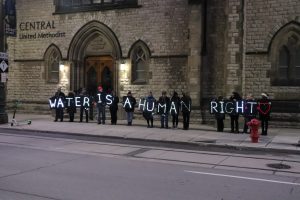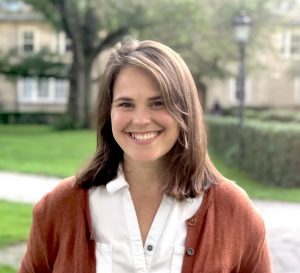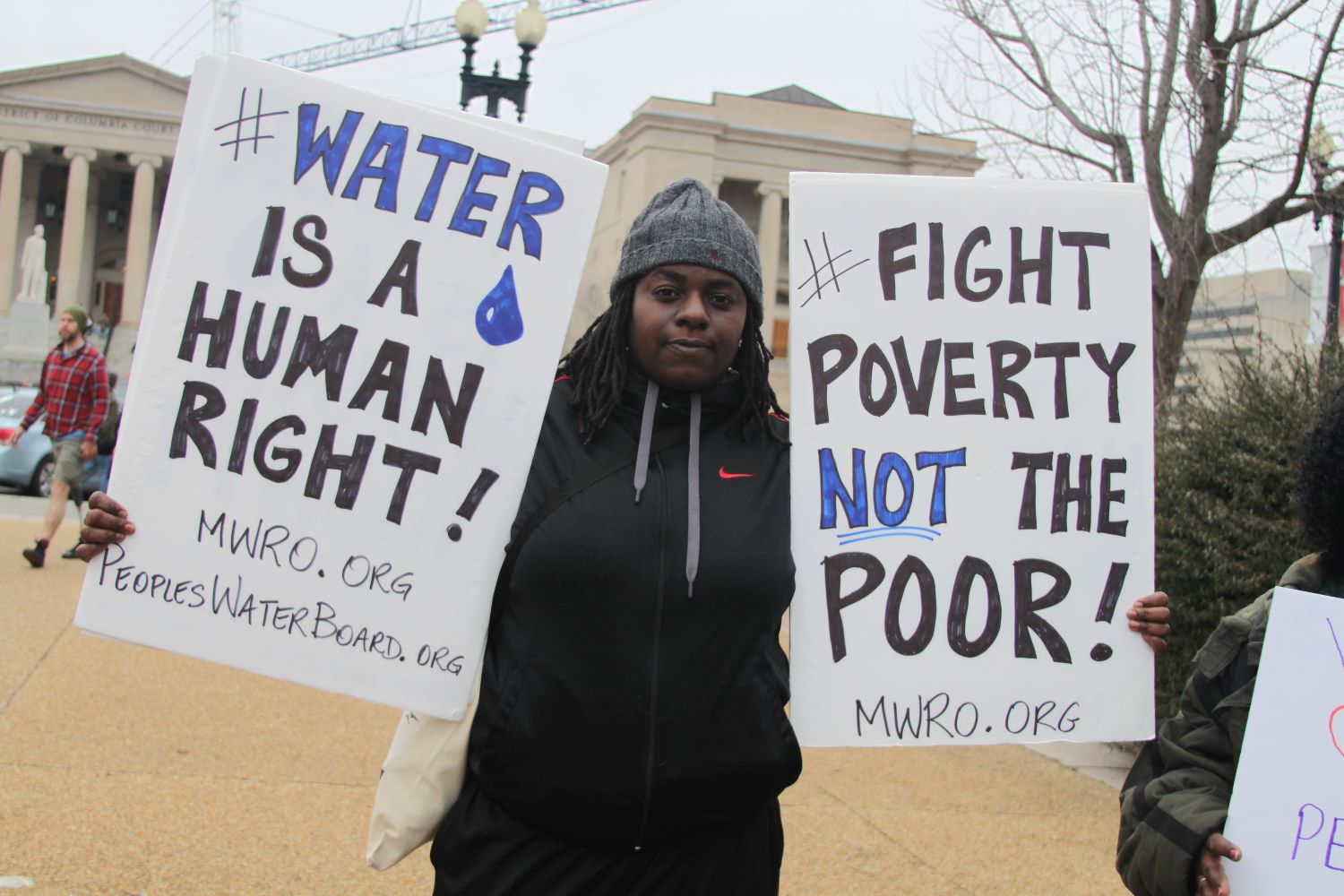Few Detroiters would be surprised to learn that water rates in the city have increased by 400% since the early 2000s. Although this statistic is staggering, Detroiters have been confronted with rising household water bills for decades. For many, water bills have moved far beyond the point of affordability, which the US Environmental Protection Agency (US EPA) defines as 4.5% of household income. A recent study by the University of Michigan shows that Detroit’s lowest-income residents spend upwards of 25% of their yearly income on water and sewer service. Water affordability is a growing concern across the United States, yet few other cities have seen such an extreme inflation of their water bills.
So what accounts for the bill increases and Detroit’s ongoing affordability crisis? Many cite the shockingly high rates of debt service following Detroit’s 2013 municipal bankruptcy, or the increasing control that banks and shareholders hold over the financing of water and sewer infrastructure. Some point to the near elimination of government funding for infrastructure maintenance. Others still insist that Detroit’s high rates of poverty and unemployment, its population decline, and long history of uneven economic development between the city and its metropolitan region are to blame. In reality, the answer involves a combination of all these elements – as well as another (often overlooked) factor. If you look at an average residential water bill in Detroit, sewage and drainage charges make up three quarters of the total bill. Wastewater and stormwater treatment is a far more costly operation than treating drinking water. Yet we don’t often link water affordability to the costs of maintaining the quality of our urban environments, like local waterways.
Detroit owns one of the largest wastewater treatment plants in the country, as well as an extensive sewer network that stretches across 944 square miles of the Tri-County area to serve 2.8 million residents. This massive infrastructural network was not engineered as a regional system from the start but was gradually expanded through the 1960s and 70s to provide wastewater treatment service to the rapidly growing suburban communities on Detroit’s peripheries. The suburbs were desperate for wastewater services in light of Michigan’s postwar efforts to curb municipal water pollution which, in some cases, included state-imposed bans on new construction wherever wastewater facilities were lacking. Within this sprawling network of wastewater infrastructure, suburban municipalities own and operate local sewer lines but share in the costs for regional infrastructure like Detroit’s wastewater treatment plant and the major interceptor sewers that convey suburban sewage to the plant. In this way, both city and suburban residents split the costs of maintaining the environmental quality of urban waterways like the Detroit and Rouge Rivers. Stormwater treatment, however, is a major exception to this distribution of shared wastewater costs. Detroiters have been paying a disproportionate share to manage regional stormwater compared to their suburban counterparts and this has contributed to the inflation of household water bills. The reason why is known as the “83/17 split.”

The “83/17 split” refers to the uneven distribution of costs to prevent combined stormwater overflows, or CSOs, which to date has amounted to more than $1.5 billion in infrastructure improvements. Residents of Detroit pay 83% of these costs, while the suburbs collectively pay the remaining 17%. This arrangement was set out in the 1999 Rate Settlement Agreement that resolved more than a decade of litigation led by suburban officials over the sharing of CSO costs. It was institutionalized under the oversight of Judge John Feikens, who presided over Detroit’s wastewater management system for nearly 30 years and was grandfathered into the lease agreement with the Great Lakes Water Authority (GLWA) when it took over the Detroit Water and Sewerage Department’s (DWSD) wastewater operations in 2015. To understand how the “83/17 split” came to be requires explaining both the evolution of the wastewater system itself and the long history of anti-Black racism that has pervaded the administrative relationships between the DWSD and its suburban customers.
Upgrading Wastewater Infrastructure Under Black Leadership
Suburban politicians and elected officials have been litigating against DWSD’s wastewater management since 1975 (to say nothing of the litigation against the DWSD’s water rates). The first lawsuit was initiated by Oakland County over a 46% sewer rate hike. Oakland County charged the DWSD with fiscal mismanagement and corruption, claiming the rate increase was an example of suburban fleecing. According to several suburban representatives, DWSD’s rate increases were “discriminatory” and “suggest[ed] that the city was swindling the suburbs.” Yet while a 46% increase was significant and unlike anything DWSD customers had seen before, Detroit administrators were taking the necessary (even if contentious) steps to respond to state and federal water quality mandates. In an interview with the New York Times, a spokesperson for Mayor Coleman Young confirmed the city was prepared to take extreme measures necessary to reduce municipal water pollution and improve the condition of local waterways.
The 1970s in Detroit were notable for two things: water quality regulations were being tightened at the state and federal levels at the same time that Detroit’s racial status quo was rapidly changing. Under the newly legislated Clean Water Act of 1972, the federal government set minimum water quality standards, mandated the use of microbes and oxidation to metabolize wastewater (known as secondary treatment), and introduced a new wastewater permit system that empowered states to determine permissible discharges according to the needs of local receiving waters. Because the Detroit and Rouge Rivers feed directly into Lake Erie, the DWSD’s permit included aggressive targets to reduce the amount of phosphorus in its wastewater discharges. High phosphorus levels were driving the growth of toxic algal blooms in Lake Erie and the federal government identified the DWSD as the “single biggest” water quality offender in the region. One Detroit Free Press article went so far as to describe DWSD’s wastewater plant as “a cancer on the long-abused underbelly of the Great Lakes system.” (As a note, it was later found that agricultural runoff from farms using phosphorus-rich fertilizers in southern Michigan and eastern Ohio did far more to raise the phosphorus levels of Lake Erie than Detroit’s wastewater discharges.) Upgrading Detroit’s treatment plant to secondary treatment to reduce phosphorus discharges was an incredibly costly undertaking. When federal officials first met with DWSD leadership in 1966, the cost estimates to bring the plant into regulatory compliance came in at a whopping $922 million (approximately $26 billion in 2024 dollars).
Even with federal support, then-DWSD Director Gerald Remus argued Detroit’s tax base could not take on the expense. By 1967, the city was feeling the economic drain of suburbanization, having lost more than 130,000 jobs and 10% of its population to the suburbs. This rate of population decline would triple in the coming year in the wake of the 1967 Rebellion. In this economic climate, Remus argued that a larger customer base was needed before such costly upgrades could be implemented. Federal water quality mandates put the DWSD in the position of having to expand its wastewater infrastructure further into the suburbs. By the mid-1970s, Detroit had added another 17 suburban communities to its system, bringing the total number of suburban contracts to 45. This expansionist logic generally aligned with suburban interests, given that a connection to the DWSD system was a far more cost-effective way to address their own wastewater obligations under Michigan state law than constructing separate treatment facilities. But concerns remained amongst Detroit administrators that the regionalization of its wastewater infrastructure would only exacerbate white and industrial flight to the suburbs.

The 46% sewer rate increase that Oakland County was litigating had been issued and authorized by two Black officials: the DWSD’s newly appointed Director, Charles Scales, and Coleman Young less than a year after being elected as the city’s first Black mayor. Detroit was also well on its way to becoming a majority-Black city, the largest in the United States by 1980. By then, more than two decades of white flight had reduced the city’s overall population to 1.2 million and its white population to 414,000 down from 1.5 million in 1950. While Oakland alleged the size of the rate increase was proof of the DWSD’s financial incompetence, the reality was that sewer rates had been artificially low under Remus and were insufficient to keep pace with the costs of managing urban water quality through more advanced (and government-mandated) wastewater treatment. Nevertheless, through the 1970s and 80s, suburban officials and the media disparaged the DWSD, labeling it as “chronically mismanaged”, saddled by “profound incompetence” and “maladministration,” and as a source of “tremendous controversy”. The charges leveled at the DWSD were the institutional echoes of longstanding anti-Black stereotypes that have disparaged Black people for centuries, portraying them as inherently corrupt, lazy, and incompetent. The racism embedded within the mischaracterizations of DWSD’s Black leadership is made yet more stark when compared to the earlier media coverage of Remus’s tenure. At a time when both the city and the DWSD were still managed by white administrators, the DWSD was credited with making “the greatest progress in controlling lake [Erie] pollution”.
Ongoing suburban opposition to the 46% sewer rate increase led the US EPA to conclude in 1977 that Detroit did not have a guaranteed revenue stream sufficient to establish compliance with federal water quality regulations. As a result, the US EPA sued the city of Detroit and placed wastewater operations at the DWSD under the oversight of federal Judge John Feikens. Feikens was not without his own anti-Black biases. One example of this sentiment can be seen in a statement he issued publicly condemning the “occupational malaise that has historically afflicted the people who run the facility.” And in a now-infamous 1984 interview with the Detroit Free Press, he remarked that “we have to give Black people the time to learn… to run projects like the Water and Sewer Department. Unfortunately, they’re still in an era of development, many of them, in which they think all you have to do is talk about the thing.” The city petitioned the court (unsuccessfully) to remove Feikens as the DWSD’s federal receiver in 1986. The imposition of federal oversight ultimately provided suburban officials with a platform to contest and renegotiate Detroit’s sewer rate increases through the 1970s and 1980s. By the 1990s, suburban litigators turned the focus of their opposition to their share of stormwater charges.
Combined Sewer Overflows and the “83/17 Split”
When Detroit’s sewer system was originally built, it was common practice to construct combined sewer systems which collect and carry raw sewage and stormwater to the treatment plant through the same pipes. It did not become the engineering standard to separate sanitary sewers from storm sewers until the 1960s and was not formally mandated by the federal government until 1970 as a condition for wastewater funding. Stormwater is exactly what it sounds like – runoff that collects in city streets and enters the sewer system when it rains or snows. During periods of heavy precipitation, more stormwater flow may be generated than the treatment plant can process, so overflow outlets exist throughout the system to release excess stormwater into local waterways. Of course, with a combined sewer system, it’s not just excess stormwater that is released, but raw sewage along with it. These overflows are known as untreated CSOs, or combined sewer overflows. Michigan has a zero-discharge policy – one of the most stringent CSO policies in the United States – meaning that all overflows are prohibited by law. By comparison, the minimum standard set by the US EPA allows for four untreated overflows per year. To correct its CSO violations, the DWSD began implementing sewer rate increases in the 1990s, which suburban officials disputed nearly every year between 1992 and 1999. This bout of litigation was eventually resolved with the 1999 Rate Settlement Agreement which institutionalized the “83/17 split”.
Suburban officials argued they should not have to pay for CSO upgrades because the majority of their sewer systems were already separated. While all suburban systems send their stormwater to the Detroit treatment plant under normal conditions, many communities are able to redirect excess stormwater into retention basins that hold it back until the treatment plant can process it, or that offer a minimum level of treatment if excess stormwater is released. Yet over the years, DWSD’s (now GLWA’s) Wastewater Master Plans have cited multiple examples of excess suburban stormwater entering into shared interceptor sewers. Melvindale, for example, uses pump stations that force excess stormwater into the DWSD system to prevent backups in their own system during heavy precipitation. Excess stormwater coming from Allen Park caused backups at the DWSD connection point until 2009. Stormwater from Grosse Pointe Park entered the DWSD system until the settlement of a lawsuit in 2000 over resultant basement flooding in a nearby Detroit neighborhood. There is little doubt that suburban stormwater has played a role in increasing the frequency of CSO events within Detroit’s combined system.
Additionally, the outlets that release untreated overflows are an inefficiency that is endemic to the shared wastewater system. They were part of the infrastructural package that suburban communities signed onto when they contracted wastewater services from Detroit – services that made it possible for suburbs to expand economically, and to grow their tax bases sufficiently to finance their own (separated) sewer networks. As for the infrastructural improvements, correcting CSOs not only requires the construction of retention basins at overflow outlets, but broader expansions to shared interceptor sewers and the treatment plant. Such expansions would not have been necessary if Detroit was only responsible for treating its own wastewater and stormwater flows. The infrastructural rationale for the “83/17 split” is shaky at best. And the officials I spoke to at the DWSD and GLWA were uncertain on what basis the precise distribution of the “83/17 split” was calculated. As the 1999 Rate Settlement agreement was being negotiated, several engineering studies were commissioned and presented to the court that estimated the suburban share of costs to be anywhere from 5-17%. Yet the modelling software that was used in the 1990s was rudimentary and the engineering studies themselves are not publicly available. With the increasing frequency and severity of heavy-precipitation weather wrought by climate change, it is more than likely that such engineering estimates no longer reflect the amount of stormwater the system must contend with. Furthermore, on a per capita basis, the balance of city and suburban users of the system no longer approximates the distribution of users when the system was fully regionalized, or even when the “83/17 split” was first introduced. Today, Detroiters make up about 20% of the users of the wastewater system yet are shouldering 83% of the costs for correcting CSOs.
The “83/17 Split” and Water Affordability
While stormwater violations make up one of the primary threats to the quality of urban waterways, correcting them has been a major imposition to residential water affordability in Detroit. To date, the DWSD has spent more than $1.5 billion on its stormwater program. This program cost approximates the estimates that were projected at the time the “83/17 split” was negotiated. As a result, it was anticipated that by 2009, Detroit ratepayers would see a rate increase of 76.3% above 1999 sewer rates, while suburban ratepayers would see a 2.8% decrease. While the program has been a water quality success, correcting 95% of all CSO violations, the “83/17 split” will continue to have an impact on the affordability of residential water bills for as long as bond debt remains from the financing used to upgrade CSO infrastructure. The DWSD and GLWA must also deal with the remaining 5% of overflows under Michigan’s zero-discharge policy.
The impact of the “83/17 split” on residential water bills became most visible in 2017 when the DWSD revised its rate setting methodology for stormwater (or drainage) charges. Ultimately, the DWSD sought to standardize its drainage rates by charging a certain rate per acre of impervious surface (the idea being that impervious surfaces, like asphalt, create stormwater runoff that enters the sewer system, as opposed to pervious surfaces, like grass, that absorb stormwater). To implement this new rate system, however, the DWSD had to isolate the revenues it must collect for stormwater management from the revenues it collects for wastewater treatment. In DWSD’s FY2017 Budget Presentation, Detroit’s stormwater revenue requirement was $151 million, $59.8 million of which was debt service related to CSO improvements. Understanding Detroit’s water affordability crisis requires accounting for the ongoing impact of stormwater management costs under the “83/17 split”.
Where Do We Go From Here?
Maintaining the quality of urban environments, including local waterways, is not a “free” or politically neutral undertaking. How we distribute the financial burden for stormwater management, and for managing environmental quality more broadly, is a question of social and environmental justice, particularly when longstanding inequities have had a dramatic impact on the affordability of water bills and on the water security of Detroit ratepayers as a result. What the water affordability crisis ultimately reveals is a discrepancy between what it costs to operate and maintain the wastewater infrastructure and what the city’s customer base can reasonably fund. But buried within this affordability gap is the uneven allocation of stormwater costs that have been assigned for improving a shared wastewater system that serves the vast majority of southeast Michigan.
As previously mentioned, the “83/17 split” was grandfathered into the lease agreement GLWA negotiated to take operational control of Detroit’s wastewater system in 2015. A year later, when the DWSD assembled a blue-ribbon panel on water affordability, their findings made clear that “water affordability [was] significantly affected by the overall costs of service and the allocation of shares of cost responsibilities across system users.” The panel recommended that DWSD “actively participate in forthcoming reviews of GLWA cost allocation methodologies and ensure equitable distributions of cost responsibilities.” Through 2020 and 2021, the DWSD did engage in discussions with GLWA officials to reconsider cost sharing for CSO infrastructure. But the joint committee concluded that the legal agreements and contracts in which the “83/17 split” is set forth make the policy “logistically challenging” to renegotiate. They also claimed that adequate data does not exist to design a new method for determining the distribution of stormwater costs. These discussions signal a clear recognition from administrative leaders in both Detroit and the suburbs that the current cost distribution is an inequitable one, but so far there is little political will to find a meaningful alternative.
A more promising development was the 2022 announcement of a $40 million Rouge Park stormwater project. Detention basins will be installed to redirect stormflow from 1,200 homes on Detroit’s west side, an area that has seen considerable flooding in the past years. What makes this project distinctive is that Oakland and Macomb Counties have agreed to cover 80% of the costs in exchange for additional flow capacity in the DWSD’s sewer system. While the agreement continues to reinforce the use of the wastewater system to support suburban economic growth and development, the project is at least an acknowledgement that suburban customers have a responsibility to shoulder some of the economic burden associated with stormwater control in Detroit’s combined sewer system to which they are attached and from which they benefit.
Moving forward, we must all pay closer attention to the ways responsibility is distributed for maintaining the quality of our urban environments, including critical infrastructures like sewer systems, and key natural resources, like water. To build more environmentally just cities, we must continue to ask who pays for and who benefits from maintaining environmental quality? This question should be front of mind as aging water and wastewater systems across the United States need replacement and as cities engage in urban infrastructure retrofitting in an attempt to mitigate the increasingly challenging effects of climate change. Ultimately, when the financial burden for environmental quality can be determined by municipal boundaries and along lines of race and class, then we are dealing with a matter of environmental injustice; one that must be recognized and remedied in all its forms and contexts. In Detroit, that requires a more equitable cost distribution for stormwater management and a commitment to water affordability for all residents.

Nickie Van Lier is a postdoctoral researcher at Dalhousie University in Halifax, Canada. Her research looks at the racial, capitalist, and colonial relations that structure how states manage urban and natural environments. Her PhD explored these dynamics through the regulation and financing of wastewater management across metropolitan Detroit. She has been involved in environmental justice organizing in Canada for over ten years, was an active member of the People’s Water Board Coalition during her time in Detroit, and continues to advocate for water and environmental justice in her research and writing.


